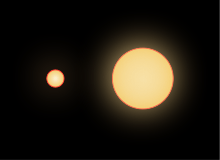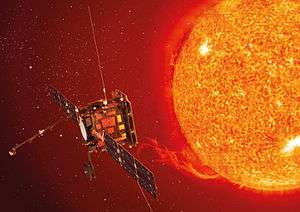Solar Orbiter
|
Artist's impression of ESA’s Solar Orbiter | |||||||||||||||||||||
| Mission type | Solar heliophysics orbiter | ||||||||||||||||||||
|---|---|---|---|---|---|---|---|---|---|---|---|---|---|---|---|---|---|---|---|---|---|
| Operator | ESA & NASA | ||||||||||||||||||||
| Website |
sci | ||||||||||||||||||||
| Mission duration |
7 years (nominal) 10 years (extended)[1] | ||||||||||||||||||||
| Spacecraft properties | |||||||||||||||||||||
| Manufacturer | Astrium UK | ||||||||||||||||||||
| Launch mass | 1,800 kg (4,000 lb)[1] | ||||||||||||||||||||
| Payload mass | ~190 kg (420 lb)[1] | ||||||||||||||||||||
| Dimensions | 2.5 m × 3 m (8.2 ft × 9.8 ft)[1] | ||||||||||||||||||||
| Power | 1100 watts[1] | ||||||||||||||||||||
| Start of mission | |||||||||||||||||||||
| Launch date | October 2018[2] | ||||||||||||||||||||
| Rocket | Atlas V 411[3] | ||||||||||||||||||||
| Launch site | Cape Canaveral SLC-41 | ||||||||||||||||||||
| Contractor | United Launch Alliance | ||||||||||||||||||||
| Orbital parameters | |||||||||||||||||||||
| Reference system | Heliocentric | ||||||||||||||||||||
| Regime | Elliptic orbit | ||||||||||||||||||||
| Perihelion | 0.28 AU | ||||||||||||||||||||
| Apohelion | 0.8-0.9 AU | ||||||||||||||||||||
| Inclination | 0-34 degrees | ||||||||||||||||||||
| Period | 150 days | ||||||||||||||||||||
| Epoch | planned | ||||||||||||||||||||
| Main | |||||||||||||||||||||
| Type | Ritchey–Chrétien reflector | ||||||||||||||||||||
| Diameter | 160 mm (6.3 in) | ||||||||||||||||||||
| Focal length | 2.5 m (8.2 ft) | ||||||||||||||||||||
| Wavelengths | visible light, ultraviolet, x-rays | ||||||||||||||||||||
| Instruments | |||||||||||||||||||||
| |||||||||||||||||||||
Solar Orbiter (SolO) is a planned Sun-observing satellite, under development by the European Space Agency (ESA). The mission will be launched with an Atlas V from the Cape Canaveral AFS in Florida in October 2018. SolO is intended to perform detailed measurements of the inner heliosphere and nascent solar wind, and perform close observations of the polar regions of the Sun, which is difficult to do from Earth, both serving to answer the question 'How does the Sun create and control the heliosphere?'
The Solar Orbiter will make observations of the Sun from an eccentric orbit moving as close as ~60 solar radii (RS), or 0.284 astronomical units (AU), placing it inside Mercury's perihelion of 0.3075 AU and providing it with the closest ever views of the Sun.[4]


Scientific objectives
The spacecraft will make a close approach to the Sun every five months. Around closest approach Solar Orbiter will be positioned for several days over roughly the same region of the solar atmosphere like geostationary satellites are stationed over particular spots on the Earth's surface, so the spacecraft will seem to 'hover' for a while over the Sun. Solar Orbiter will therefore be able to watch magnetic activity building up in the atmosphere that can lead to powerful solar flare or eruptions.
Researchers will also have the chance to co-ordinate observations with NASA's planned Solar Probe Plus mission which will make in situ measurements in the Sun's extended corona.
The objective of the mission is to perform close-up, high-resolution studies of the Sun and its inner heliosphere. The new understanding will help answer these questions:
- How and where do the solar wind plasma and magnetic field originate in the corona?
- How do solar transients drive heliospheric variability?
- How do solar eruptions produce energetic particle radiation that fills the heliosphere?
- How does the solar dynamo work and drive connections between the Sun and the heliosphere?
Payload
Observation packages of baseline mission definitions:[5]
- Heliospheric in-situ instruments
- Solar Wind Analyser (SWA): To measure solar wind properties and composition
- Energetic Particle Detector (EPD): To measure suprathermal ions, electrons, neutral atoms, as well as energetic particles in the energy range from few keV/nuc to relativistic electrons and ions up to 100 MeV (protons) and 200 MeV/nuc (heavy ions)
- Magnetometer (MAG): will provide detailed measurements of the magnetic field
- Radio and Plasma Wave analyser (RPW): To measure magnetic and electric fields at high time resolution
- Solar remote-sensing instruments
- Polarimetric and Helioseismic Imager (PHI): To provide high-resolution and full-disk measurements of the photospheric magnetic field
- EUV full-Sun and high-resolution Imager (EUI): To image various layers of the solar atmosphere
- EUV spectral Imager (SPICE): To provide spectral imaging of solar disk and corona, characterize plasma properties at the Sun
- Spectrometer/Telescope for Imaging X-rays (STIX): To provide imaging spectroscopy of thermal and non-thermal solar X-ray emission from 4 to 150 keV
- Coronagraph (Metis): To provide simultaneous UV (121.6 nm), and polarized visible light imaging of the corona
- Heliospheric Imager (SoloHI): To image quasi-steady and transient flows of the solar wind
Timeline and status
- 2012 April : €300M contract to build orbiter awarded to Astrium UK.[6]
- 2014 June : Solar shield completes 2 week bake test.[7]
See also
- Advanced Composition Explorer (ACE), launched 1997, still operational.
- Solar Probe Plus, planned probe to 8-9 Rs
- Solar Sentinels
- STEREO (Solar TErrestrial RElations Observatory), launched 2006, still operational.
- WIND (spacecraft), launched 1994, still operational.
References
- 1 2 3 4 5 "Solar Orbiter Mission". ESA eoPortal. Retrieved 2015-03-17.
- ↑ "Solar Orbiter - Development". NASA. March 3, 2015. Retrieved 2015-03-17.
- ↑ "NASA Selects United Launch Alliance Atlas V Rocket to Launch Solar Orbiter Mission". United Launch Alliance. Digital Journal. 18 March 2014. Retrieved 2014-03-19.
- ↑ KIS - Solar Orbiter
- ↑ Solar Orbiter overview (2013)
- ↑ "ESA contracts Astrium UK to build Solar Orbiter". April 2012.
- ↑ "Solar Orbiter's shield takes Sun's heat". June 2014.


